~ page 14 B ~
~ The Study of Threes ~
http://threesology.org
Researchers as of 8/29/2019
| Devil's Advocate Series: | ||||||||
|---|---|---|---|---|---|---|---|---|
| 1 | 2 | 3 | 4 | 5 | 6 | 7 | 8 | 9 |
| 10 | 11 | 12 | 13 | 14A 14B |
15 | 16 | 17 | 18 |
| 19 | 20 | 21 | 22A 22B |
23 | 24 | 25 | 26 | 27 |
| 28 | 29 | 30 A | 30 B | 31 | 32 | 33a | 33b | 33c |
| 34 | 35 | 36 | 37 | 38 | 39 | 40 | 41 A | 41 B |
Note: I am prompted to split the #14 page of this series into two after re-encountering the 2-3-4 example portrayed in the DNA representation: 2 strands, a Triplet code, and 4 amino acids. While I have thought about this example on many previous occasions, I actually took it for granted that I had already included it in this pages section of examples. When I was awakened last night (Feb. 11th, 2021) with the pattern in mind, I jotted it down with the intent of checking the page to insure I had included it. Since it was not (to my great surprise) and the bulk of the page was so large, I decided to include the example as well as split the page into two sections so that they will load faster. In addition, the pattern 3-5-8 has come to mind, though some examples seem to be allocated disjointedly... that is, in other words, requiring a bit of fudging so as to represent a complete picture since the human mind (at its present stage of evolution), appears not to recognize patterns occurring as a singularity when the requirements involve examples spread across time, place and subject matter, instead of at the same time in the same place in a singular subject. Needless to say that when a three-patterned ensemble arises in a given item like the foregoing DNA example, an observer can easily overlook its presence because it is not a conventional pattern being taught to look for in customary academics.
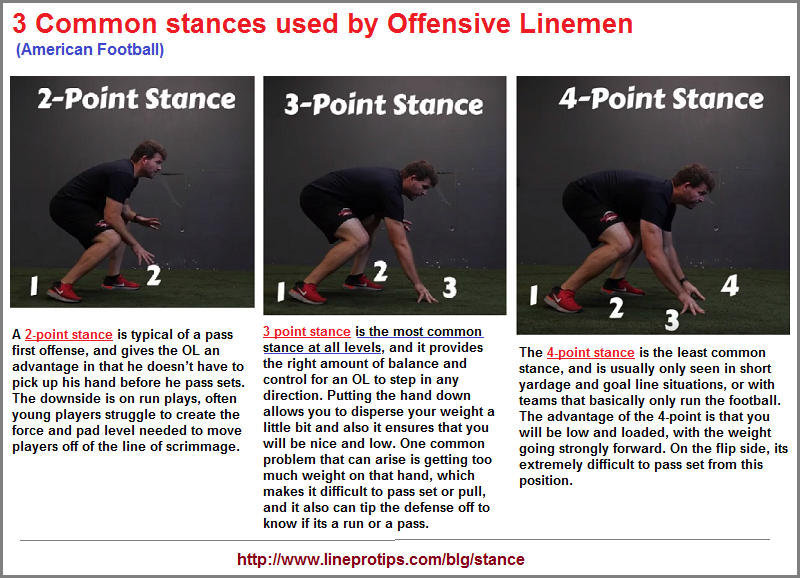
(example added: 8/27/2021)
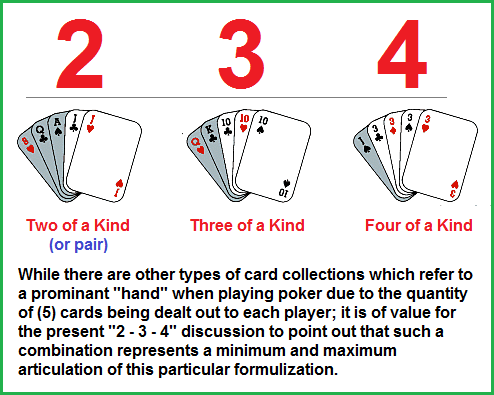 |
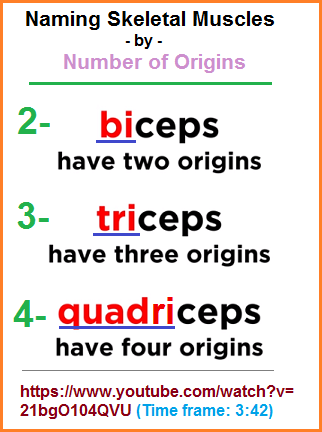 |
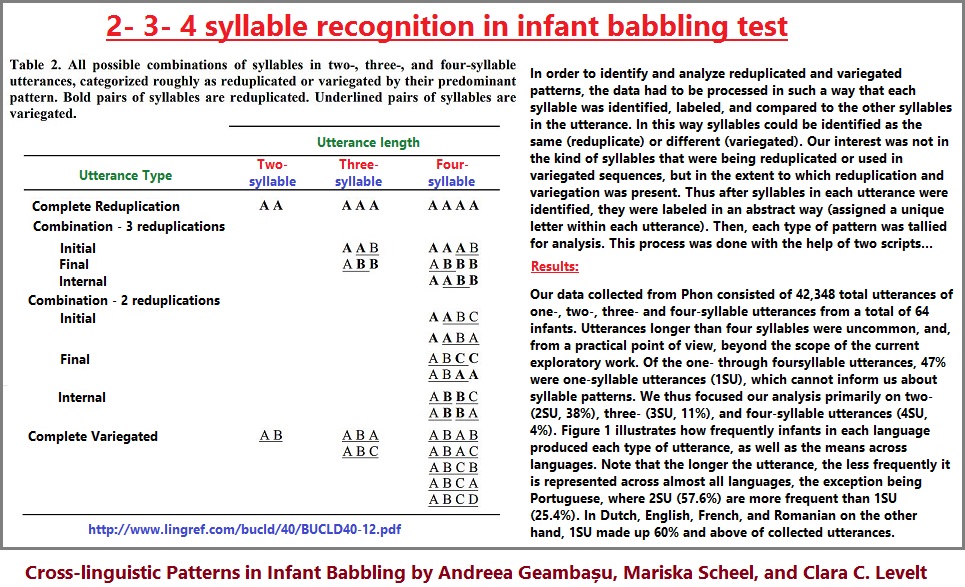
Image added: 9/11/2021
Item example added: 1/7/2023:
in the music of India, Bangladesh, and Pakistan, a metric cycle with a specific number of beats—from 3 to 128—that recur in the same pattern throughout a musical performance. Tala might generally be equated with rhythm or metre, although the tala procedure has no precise counterpart in Western music. The concept of tala is found in rather different forms in northern (Hindustani) and southern (Karnatak) Indian music. In the north, beats appear in groups of two, three, or four and include strong as well as "empty" beats. The character of the beats and their subdivisions is represented by rhythmic syllables that are recited for practice and sometimes in performance; these syllables correspond to various types of strokes with the finger on the appropriate drum. Southern Indian talas consist of units of one (anudrutam), two (drutam), and three to seven (laghu) beats... ("tala." Encyclopædia Britannica, 2013.)
Please note that in most cases, the idea of a "2-3-4" (triple-based) ensemble of cognitive activity is unacknowledged by those using such, because this and other recurring ensembles is not a conventional way of perceiving reality. I too had to learn of its "obvious" presence over time. However, I can not exactly say when this particular grouping came to mind except that the idea of triple-based ensembles which differed from the typical 1-2-3, ABC, XYZ varieties had an initiation by seeing the old article title of "The Magical Number Seven, Plus or Minus Two: Some Limits on Our Capacity for Processing Information by George A. Miller, in a different light (because I refused to admit to the supposed significance of the "7" value)... and used simple mathematics to realize that the title actually displayed the three-patterned ensemble of 5-7-9 as an emphasis that was being over-looked.
Now, let me return to the 2-3-4 discussion involving the "two" attempting to grow into a "three" through the usage of repetition, just as we can see it occurring with the "three" being repeated and the presumed "four" is actually a repeated 3-to-1 ratio (three... stop... three... stop... etc... like 3 stop and 1 start codons) as a transcription occurring in multiple forms. For example:
This is the same thing we see in our usage of a comma to separate groups-of-three numbers in counting sequentially (ones-tens-hundreds... comma... thousands-ten thousands- hundred thousands... comma... etc.). The comma acts as a point of demarcation to point out a limitation in cognition has occurred and is repeating but that there is the usage of repetition to give the impression of acknowledging the presence of something beyond the boundary of present considerations which have stopped at the "three"... perhaps due to an environmentally influenced genetic constraint; just as the described primitive's usage of one or another word such as "many, much, more" (in their own language equivalent way), to describe that which is beyond the "two" in their counting systems that they become very adept at using... like a person skilled in the usage of an abacus and can compete with those using an electronic calculator within the scope of the general math problems of the same degree.
In short, the usage of doubled repetition... and then repetition with greater speed, is often used to give the impression of having progressed beyond a certain level of achievement, when this is not the actual case. The primitive system remains, though it can be quite adept at what it does, applied to multiple interests and aspects of everyday life (like the horse once used for practical applications of mobility, toil, food, etc...), yet its multiplicity of usage, even with increased speed (such as the binary system in computers), is not an actual step into a third realm of consciousness usage. Like the Chinese Trigrams which are actually Bigrams, the Christian and Hindu Trinities are actually references to a "two-patterned" formula of thinking giving expression to an unrecognized desire for mental activity that wants to exceed itself and thus compounds dualities with repetitive utterances (like chants and songs and sermons) that are duplicated and offered in faster terms to give an impression of a higher sense of consciousness— that has yet to be achieved, and can not be done until a fundamental change in the brain occurs... which it has, but has no presently viable environment in which to fully prosper... it is forced to live and adapted within a dominant social culture where a "two" mindset is pervasive in business, government and religion.
Is a metaphor of the "2-3-4" pattern-of-three to be found in the debate surrounding the 432HZ idea in music theory and its supposed relationship to some healing property important for human consciousness and other physical states? Yet, the 432Hz is companioned with two others (440, 528), thus yielding a trinity of tuning frequencies; all of which when subjected to various mathematical derivatives (such as addition, subtraction, multiplication, division...), will yield varying combinations related to other patterns to be found in multiple subjects, but is a digression not being traced out in the present discussion.
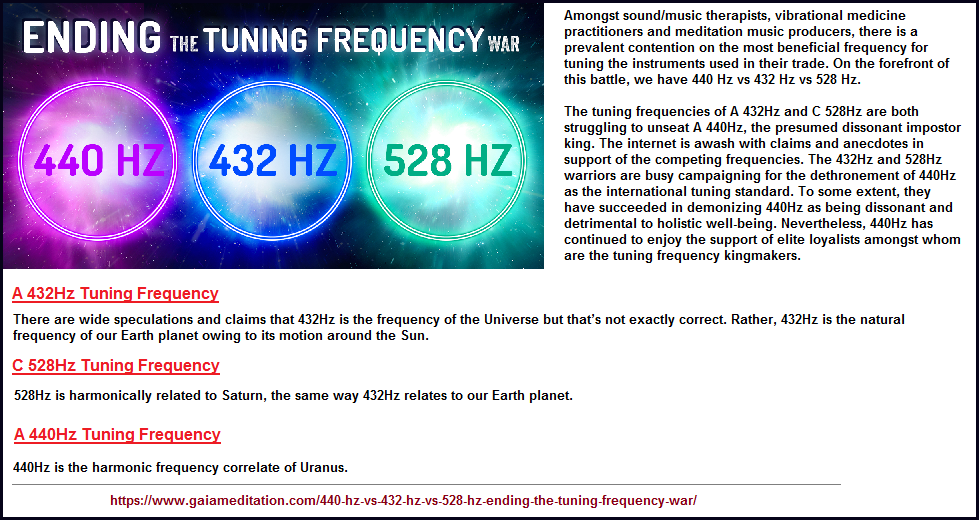
Similarly, can we speak of the American construction of social security numbers (3-2-4) (3 numbers separated by a hyphen, 2 numbers separated by a hyphen) as another example of the 2-3-4 sequencing except that its 3-2-4 sequencing mimics the dominance of cognitively aligned number patterns used in the culture? (In other words, the pattern of number groupings in social security numbers reflects the dominant cognitive alignment of enumeratable ideas (ideas that can be translated as representing some number value) either written (words/illustrations/graphs, etc...), spoken or artistically arranged? Does the 3-2-4 of social security numbers reflect the dominant cultural usage of cognitive patterning in that patterns-of-three are foremost, patterns-of-two are secondary, and patterns-of-four (or 3-to-1) are tertiary, with other identifiable patterns as being used less?

An example of the human mind engaging in a mirror-imaging orientation is the old idea in which it was argued that the Sun rotated around the Earth, and is commonly described as an expression involving the ego-centricity of humanity alternatively noted by the once wide-spread practice of map makers who would place a given kingdom on the center of a map, so as to fulfill the egotistical desires of their patron king whose Narcissism placed themselves and their kingdom in the central position of their world-view... in which "the world" (as their small minded brains could conceive of it), saw everything in one or another socialized orbit around themselves. Other examples are the variously adopted dichotomies which some people obsess over in their own world-views, as if they are proposing an enhanced perception of reality in direct opposition to a status quo acceptance frequently practiced via traditional observances. It is not that such dichotomous portrayals are wrong and the traditions are right... or vice versa; but that this is the typical strategy being played out time and again in different eras for different subjective interests as an indication of a recurring mental activity whose generality or commonality does not evolve into any higher order thinking (whatever this may actually mean since a commonality of thought has difficulty in grasping what this may mean due to an insistence of using ego-centrically definable methodologies of interpretation).
In stead of evolving into a higher order thinking, a practice of artificialization takes place in terms of metaphors via a type of linguistic gymnastics which creates the illusion, if not delusion, of an evolved thinking process inclined towards thinking a given idea represents some Natural or Universally applicable truth.
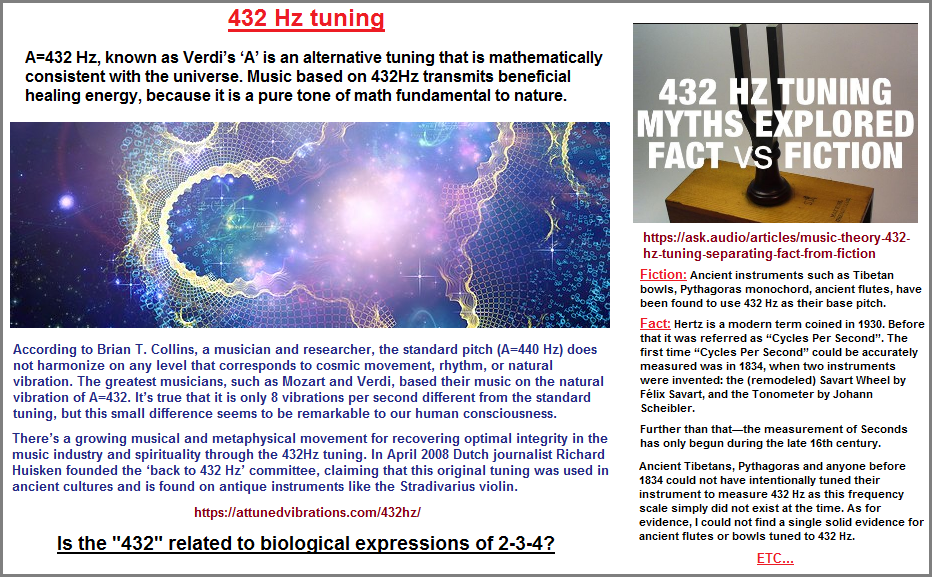
Note: The introduction of the above idea which questions the possibility of a biological connection between the two expressions, takes the discussion to a whole new level of consideration. Whether or not ancient peoples understood the mathematics or scientific measurement of the "432", does not mean they did not have some inherent instinct for it. This is not to say that I agree with the comments, but playing the Devil's Advocate requires alternative suppositions.
In gathering information for the "under-construction" timeline, biological references of events preceding the development of humanity is a requisite. Yet, so too is the understanding that recognized patterns exhibit resemblances to other functionalities such as those which may be alternatively described as a mechanical, electrical, fluidic, etc., model. A model used in one subject may well be applied to another subject, though a bit of "tweaking" or re-labeling needs to be applied for a given context. In any respect, one of biological events which needs to be addressed in terms of the modeling it portrays, is photosynthesis. Whereas one can find references to two stages, three stages, and four stages... like so many other pre-and post human biological events, we find a stark absence of stages with larger number activities. In other words, there are no references to 10, 20, 30, one-thousand, etc... stages. All of them are expressed as occurring in very low number activities. And amongst these 1 to 9 or 10 number references, we find a predominant usage of 2, 3, and 4, while other instances may add or subtract from this three-patterned grouping to produce another set-of-three such as 3,4,5... 4,5,6... 5,6,7... or some combination thereof (mix and match as you care to). Nonetheless, a constraint... or if you prefer... a conservation of events is the recurring model of activity.
In speaking of biological events, we often see such words as "cycles" or "phases", or "events" some other characterization revealing a movement or dynamic. Stasis or stationary, or static events are generally described in reference to movement, acceleration, or some other aspect of time interrelated speed or specification. This is of interest and importance to mention because it references a mindset that is focused on some sort of mechanization, to which we can follow-up on with examples from mechanical operations such as the internal combustion engine as an analogy.
Let us first take an example of the "two-phase" model of photosynthesis and compare it with a "two-cycle" gasoline (or petrol) motor:
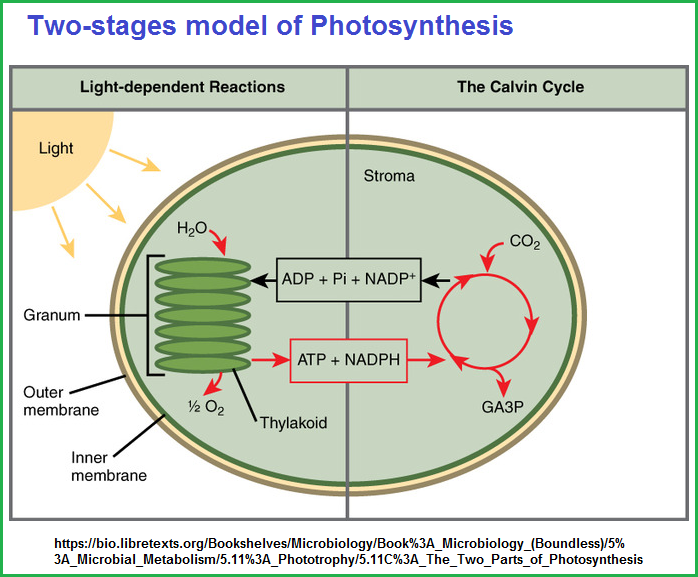 |
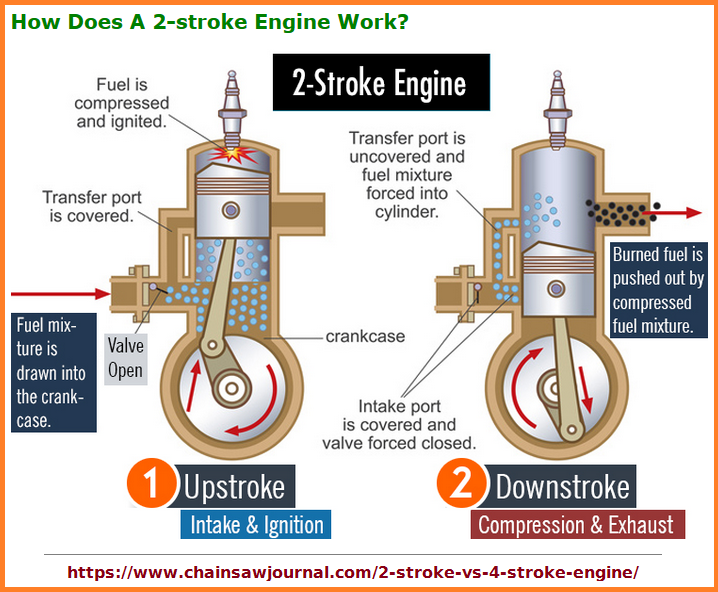 |
Now let me provide a 3-stages model of photosynthesis with a 3-stroke rotary engine:
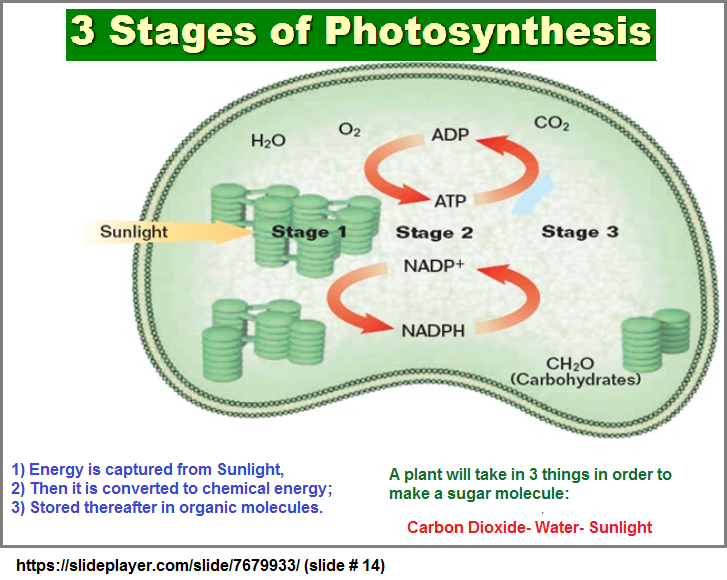 |
 |
Let us now move on to a 4-stages model of photosynthesis and a 4-stroke engine:
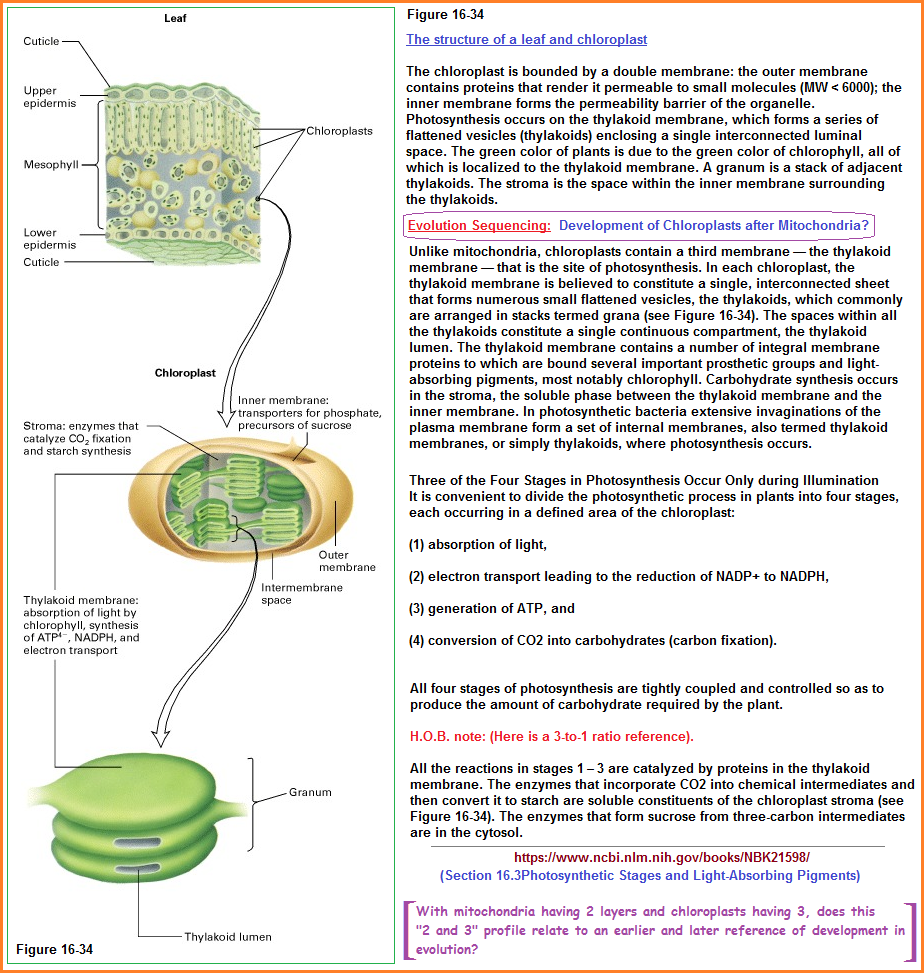 |
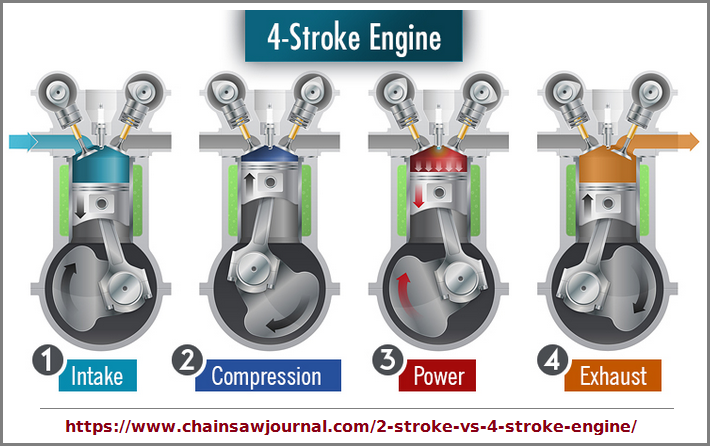 |
Another interpretation of the "4-stroke" engine would be to view it as a 3 to 1 ratio, with the first three combined as a set in relation to the exhaust phase. The reason for making such a reference is that usage of the "3-to-1" label may be more beneficial when examples from multiple subjects are combined and compared. In any respect, the preceding "2, 3 and 4" phase models of cyclicity can be reference altogether as a 3-patterned group detailing different vantage points of perception which have been put into construction. This does not mean each stage was preceded by a simpler phase or that there was a successive stage of development as is described here, since, for example, we label the "mesoderm" of the three Germ layers as the middle layer, though it arrived after the ectoderm and endoderm. Even though it occurs centrally between the two, it evolved later on as the 3rd development. Without knowing this, one might be led to assume it arrive second in terms of evolutionary development.
The point to be made is how do we want to interpret the activities of photosynthesis from which to derive the best model in the overall analysis being undertaken in the timeline sequencing? Is it two-patterned, or three-patterned, or four-patterned, with respect to evolutionary development? And no less, why does the activity found in the different models of internal combustion engines resemble the same thinking processes applied to an interpretation of photosynthesis? Because it is natural, or is it a contrivance of the human brain subjected to unrecognized social and environmental constraints? And yet, this comparison is not enough. Let us now add the basic designs being applied to different engines in order to identify the basic underlying profiles which we also see in the diagrams being utilized by biologists to describe biological events:
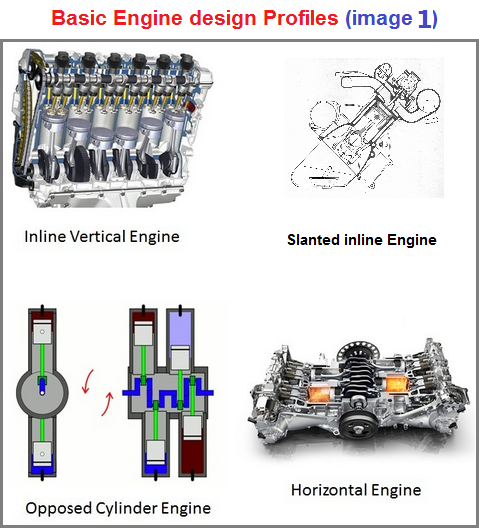 |
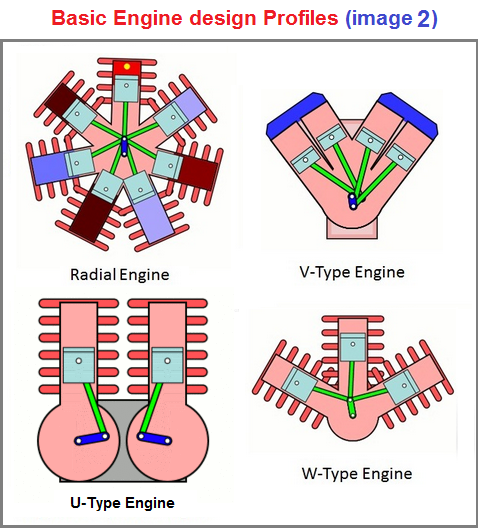 |
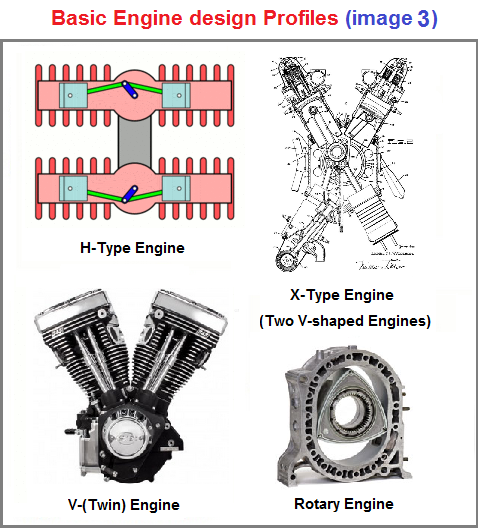 | |
Examples of the different pages looked at in the research of engines (besides what I could remember from working on several different kinds)>
| |
|
Since engines are referred to as having "horse power", (used as a selling point long ago to encourage horse owners to find a relationship between their horses and the automobile so as to give up their ownership of horses for an ownership of a vehicle), let us view a "2- 3- 4" pattern with respect to the mobility of horses: 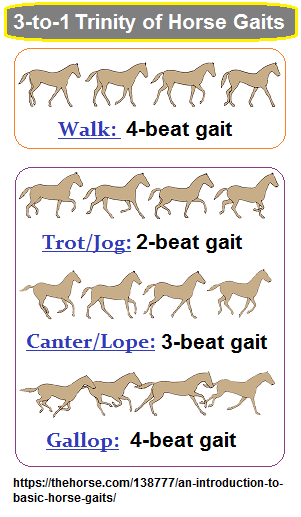 Trios or Trinity or Tryptch? 3rd section of the 1st page | |
|
Mechanical models for living cells--a review. (Authors: Lim, Zhou EH, Quek ST.) Nano Biomechanics Laboratory, Division of Bioengineering and Department of Mechanical Engineering, National University of Singapore, 9 Engineering Drive 1,
Singapore 117576, Singapore. ctlim@nus.edu.sg
Abstract: As physical entities, living cells possess structural and physical properties that enable them to withstand the physiological environment as well as mechanical stimuli occurring within and outside the body. Any deviation from these properties will not only undermine the physical integrity of the cells, but also their biological functions. As such, a quantitative study in single cell mechanics needs to be conducted. In this review, we will examine some mechanical models that have been developed to characterize mechanical responses of living cells when subjected to both transient and dynamic loads. The mechanical models include:
Based upon these models, future attempts can be made to develop even more detailed and accurate mechanical models of living cells once these three factors are adequately addressed:
|
|
Note: When speaking of "adherent cells", this can easily be translated into "adjoining cylinders". Frequently there is the experimental procedure to use a one-cell model that can be described in terms of creating a one-cylinder model. "Structural heterogeneity" gives the impression of balance, since an unbalanced engine can rattle itself apart. The "constitutive relations" gives the impression of inter-cylinder relationship functioning. The "Active Forces" reference is clearly related to timing, fuel mixture, spark advance, combustion pressure, fuel octane, etc...
In the foregoing engine profiles, we see the simplistic designs of horizontal, vernicle, diagonal, circular and triangular. These are the same types of patterns the human mind is employing to its game theory strategies. These are being pointed out to make reference to the fact this is yet another indication that the human mind is being subjected to a restraint that appears to be linked with a rationalized system of survival mechanisms striving for some semblance of equilibrium in an incrementally deteriorating environment which is leading humanity along a course of extinction. We now need to compare these basic designs with the basic designs found in biological body plans:
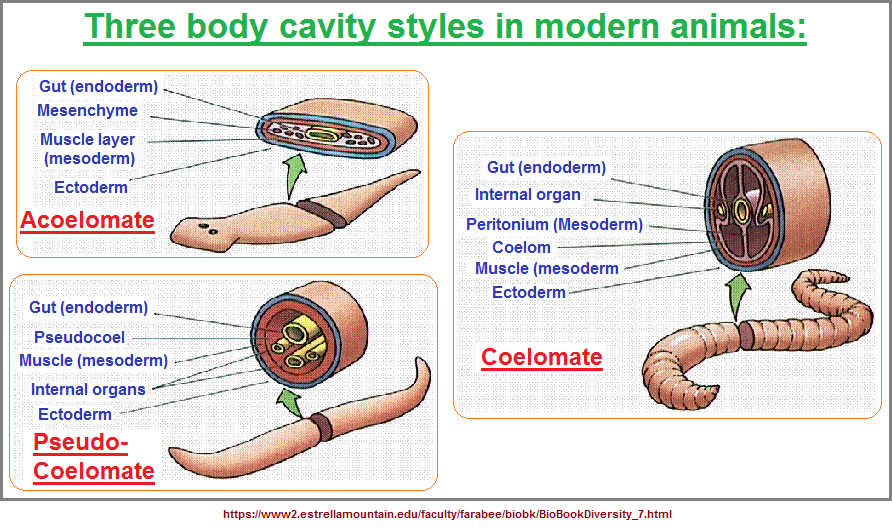 |
 |
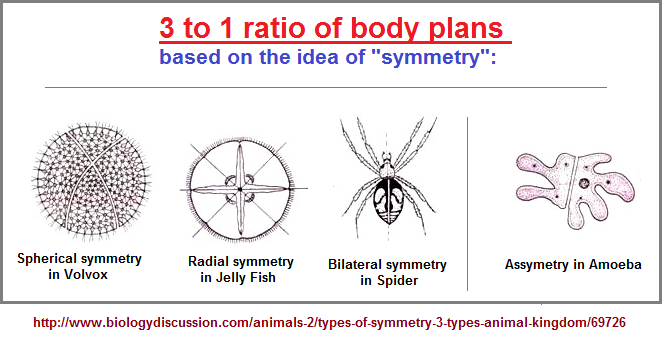 |
Is the human mind expressing itself in a recurrence of activity reminiscent of biological development which apparently follows a 1-2-3 maturational development sequence that does not necessarily proceed in a smooth and uninterrupted fashion with and without reversals, extinction, rebirth, mutation, and overlap with previous versions of similar variations from which later variations emerged but became separated from.
In other words, because we pay witness to a recurrent beginning to end or present example of the latter development... and many of the examples are expressed in a sequential three-part order, this does not necessarily mean such a sequence actually occurs, but that the human brain's orientation in this respect must utilize the model of expression it has as a functionality. If the patterns we see in biological and mechanical models reflect a human mindset formulated as an artificiality of environmental pressures, the low numbers being applied to the models may be an expression of an impression detailing the existence of one or more constraints which are forcing humanity into developing perceptions and a resulting culture of logic and intelligence that is appropriate to maintain a viable measure of equilibrium on a course that is headed for extinction... since it is known that the environment is directed towards an eventual obsolescence. The low quantity of models coupled to the low number values of cycles, phases, interactions, etc., are the expressions of a nature forcing life forms to conform to a process of adaptation most suited for short-term survival that is rationalized away by various social moods, government policies and cultural trends of saving this or that life form through a positivation of a prevailing negatively occurring reality.
Before leaving this page in order to continue it on the next installment of this series since so many images are being used, let me include a third representation of the "2-3-4" pattern by providing some images of the three different types of vertebrate heart, which can be contrasted with the so-called hearts of the cockroach and earthworm:
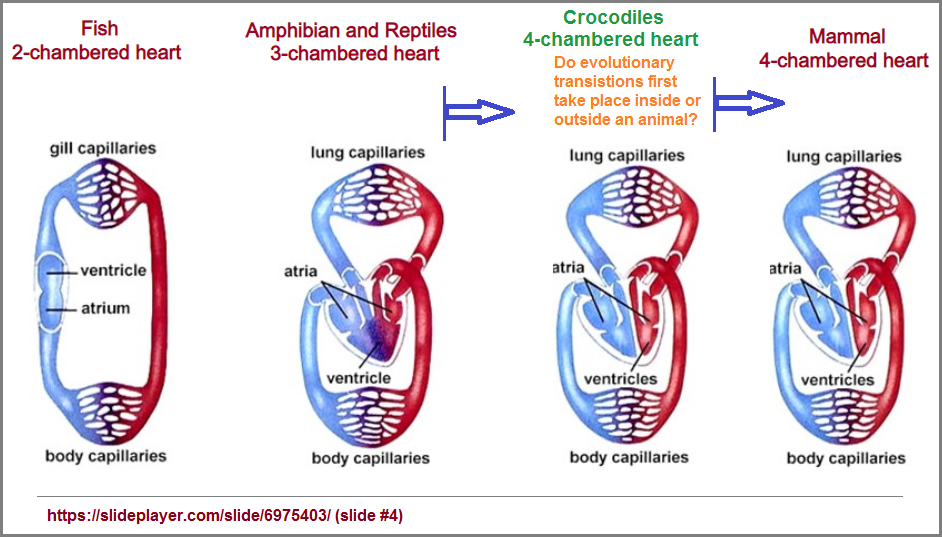
|
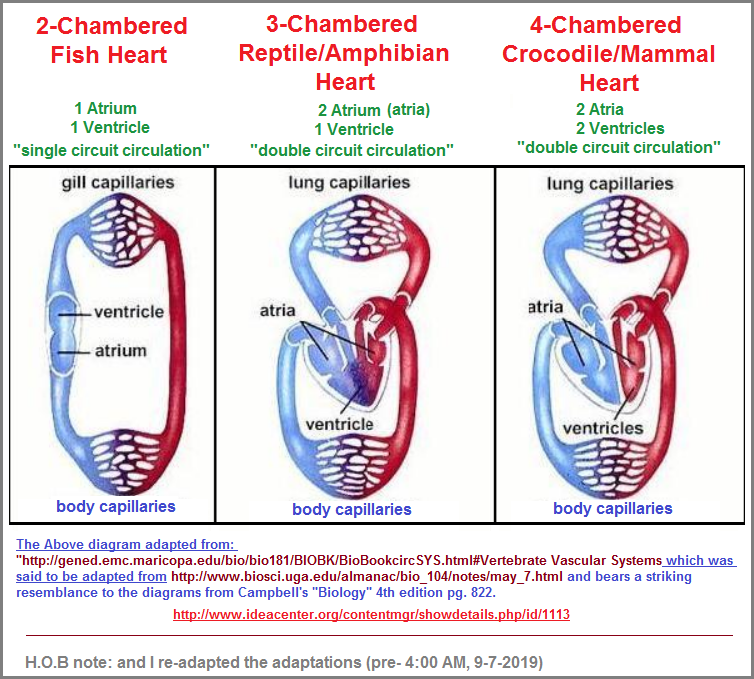
|
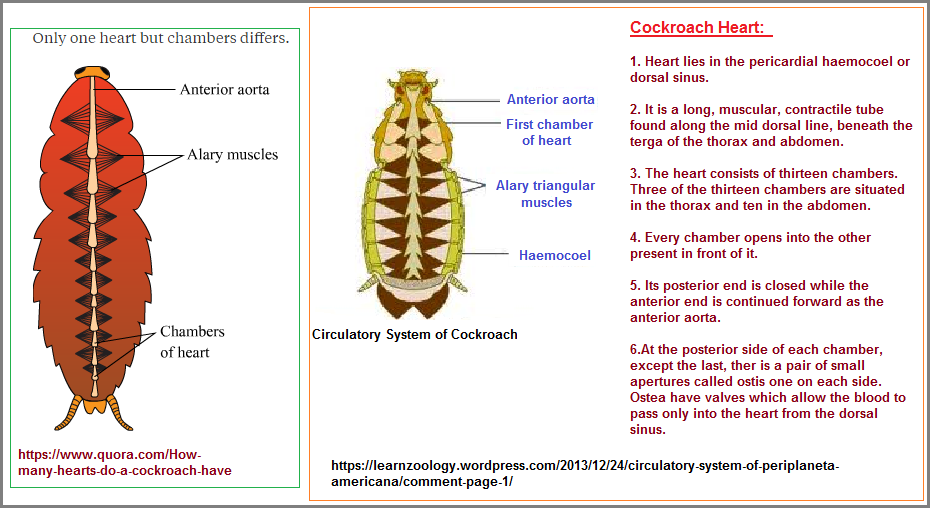 |
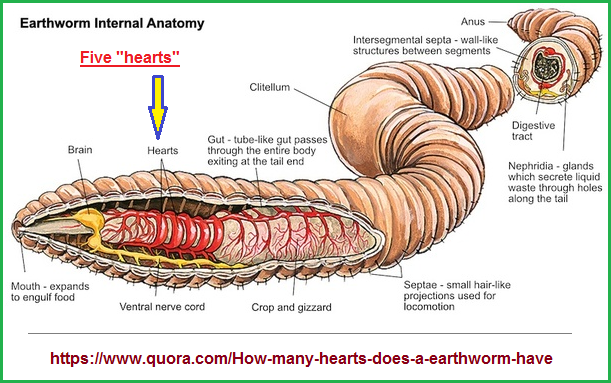 |
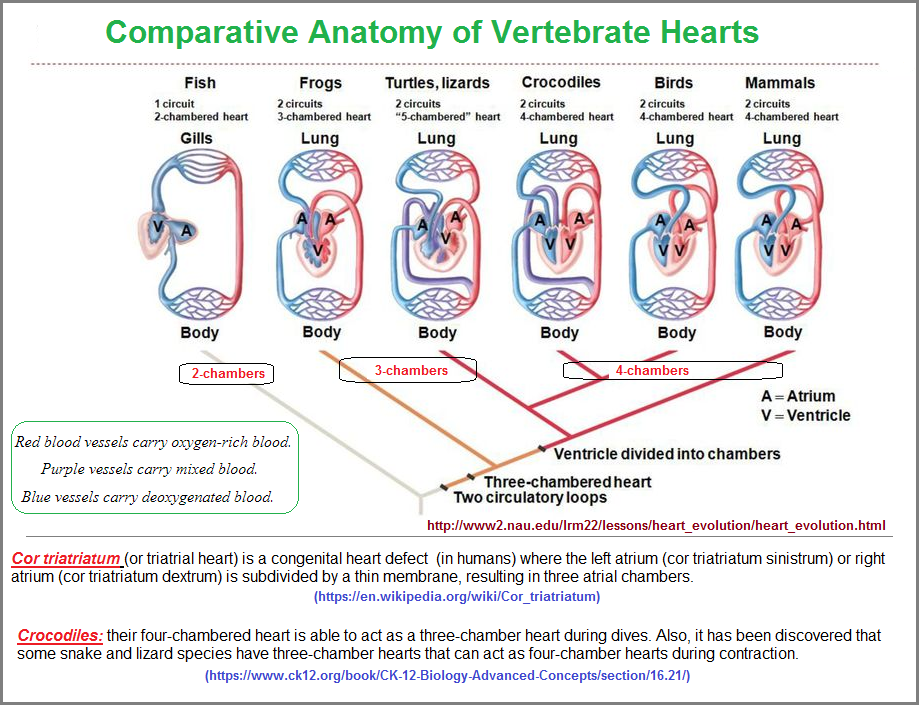 |
When looking for examples of developmental evolution, a clear representation of a "1-2-3" sequence of development may not be readily available nor even encountered. However, alternative sequences may be plentiful from which we can provide a provision for their placement on the evolutionary timeline, though the idea of a one-two-sequence may have to be stuck in a "supposed-to-have-occurred" framework of possibility. Just because we prefer some neat and tidy 1-2-3 maturational development sequencing model, doesn't mean we will be able to find one and must therefore use what we have uncovered. There may be no existing representation of an early, later, central (or otherwise) character to provide for a presumed existence. Unless we want to assume that there is, on occasion, some spontaneous creation of a given biological event, then we will have to continue thinking in terms of transitional stages, whether or not we can find such "missing links" in the 1-2-3... chain. We simply continue to think there was a one which came before the two and that the "three" placement may or may not be the final word of development. For example, we have five fingers and five toes, more or less than this numerical value is considered to be an anomaly. But it doesn't have to keep us from thinking why there are not an abundant expressions of the "five" such as having five eyes, five heads, five noses, etc... Something is keeping this from happening and also constraining the quantity of events in biological processes to be limited in expression... just as we have a limited number of elements and limited number of organelles in a cell and a limited number of sub-atomic particles, etc...
Origination date (of page heading: Friday, September 6th, 2019... 3:54 AM
Initial Posting: Saturday, September 7th, 2019... 12:47PM
Latest Updated Posting (before splitting): Tuesday, November 10th, 2020... 5:54 AM
This section split into two pages at: 7:56 AM, 2/11/21, Thursday
Updated Posting:Tuesday, January 17th, 2023... 12:24 AM
Herb O. Buckland
herbobuckland@hotmail.com